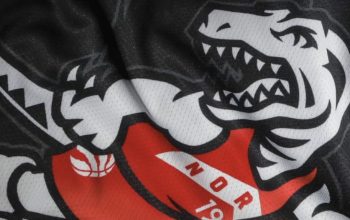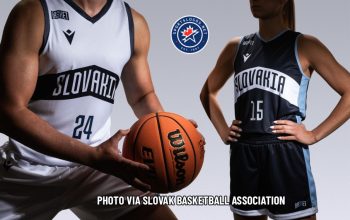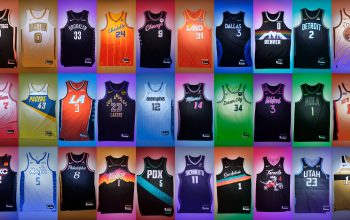
It was the mid-1990s. Purple was trendy, and a new expansion NBA team in Toronto needed to break through the hockey-thick culture to attract youth. There was nothing better than an oversized green raptor on a purple uniform. Well, until that raptor turned red.
The Toronto Raptors started play in the NBA in 1995, offering up a movie-inspired dinosaur name and clad in purple, red, black and white. Getting to that point, though, was primarily driven by then-owner John Bitove and his family’s love of the “Jurassic Park” movie, says Tom O’Grady, then the creative director for NBA Properties and now partner and chief creative officer of Gameplan Creative in Chicago.
“When the movie came out with the ferocity of the evil villain being 6-foot-tall raptors, that echoed in everybody’s thought process,” O’Grady says. “And there was not a professional team named after dinosaurs. We all felt like it was a cool direction to go.”

Sure, Toronto officially offered up a bevy of names on which the fans could vote. The listed included the Beavers, Bobcats, Dragons, Grizzlies, Hogs, Raptors, Scorpions, T-Rex, Tarantulas and Terriers. The Huskies, thanks to the historical use of the name in the city, had some draw too but was discarded early. The Hogs played off Toronto’s “Hogtown” nickname, and Dragons was considered, as O’Grady says, almost as a placebo.
Three nicknames started to take hold for Toronto, the Raptors, Dragons and Terriers. “The owner and his family fell in love (with Raptors),” O’Grady says. “They did focus groups for a sanity check, but deep down John Bitove wanted Raptors as the name and something had to happen to dissuade that.”
In the nickname selection process, the design team took logo mockups and slapped them on an 8.5×11 sheet of white paper in landscape with black Helvetica font. They looked at how the design balanced, how the letters worked, if the mark must be icon or wordmark driven and if it needed a basketball in it. The mid-90s unwritten rule was “yes” for a basketball, mostly to help an expansion team gain market share globally.

The design team sketched out only three names, the Raptors, Dragons and Terriers, but focused mainly on the Raptors. “We liked it and thought it was unique,” O’Grady says. “We liked where it could take us, and 75 percent of the up-front work was being done on the Raptors. Terriers was cute and fuzzy, and Dragons could have been anything, it was too generic. That is how it came to Raptors and then we said, ‘let’s go.’”
(In an aside, the mockups for the Dragons almost later turned into the New Jersey Swamp Dragons when the team considered a massive rebrand.)
With the Raptors the chosen name — a nickname that would attract youth, tie to culture and play well on merchandise — it was time to push forward on fleshing out the identity.
“Creativity and being different usually won the day in making decisions,” says Bitove

From the first sketches, the Raptors logo with the circular shape with the wordmark arched behind the animal and his feet with claws stuck out. “We focused on that one and pushed the heck out of it to where it became the final Raptors look,” O’Grady says. It was eight weeks from soup to nuts.

The legal side of things was incredibly fast too, with Raptors a really clean name to trademark (Toronto also did the legal work on the Dragons, which was also easy, but for the opposite reason as there are so many dragon themes in culture it is almost as if it is common property).
Then came the colour. “We were having a hard time stumbling on a colour that nobody else had,” O’Grady says. “That is hard. Then we focused on what is a colour combination that might go together that nobody has.” Initially that meant, for Toronto, purple, green, black and bronze, all with a green raptor. Then just before the final approval from Bitove, the design team received a call from the owner that some of the investors were pushing back that the logo didn’t represent Canada.

“Let’s change the raptor to red and reflect Canada without having a maple leaf,” O’Grady remembers from the process. “It was kind of fun. We can do this. We did a quick flip and re-rendered the file and within a day, that was it. If we can protect this, then off to the races we go. That is when we anointed the raptor red because it had to have some Canadian influence.”
The change has served the franchise well, even to today as the only Canadian NBA team embracing red with the moniker “We the North.”
For the purple, Toronto wanted to stay away from the shades used by the Lakers, Suns and Jazz, eventually selecting PMS 266 for a unique twist. “There was a lot to be learned by the Charlotte Hornets when they introduced teal into the sports landscape,” O’Grady says. Purple PMS 266 was to be to Toronto as teal was to Charlotte and while some licensees struggled to match the colour, the sublimation used on NBA jerseys allowed for an exact match. “It was like somebody put a PMS book on a piece of clothing,” he says. “One of the joys of sublimation, you get exactly what you want.”

With a six-month window allowing expansion teams to reap 100 percent of merchandise profits sold within 75-miles of the home city, the Raptors knew they had to do whatever necessary to maximize those initial sales. Instead of sweeping up the cutting room floor during the original logo design process, the placed the runner-up designs straight onto merchandise, whether it was the infamous raptor “humping” logo (the raptor fully embracing a basketball), the “TR” logo, or that ever-popular claw mark.
“People went bonkers for that,” O’Grady says. “It was such a departure from the primary, busy logo.” Having the claw live on the shorts of the uniform also gave it some real official backing.
During design, the team ensured they could pull the full body raptor out in a “peelable” logo design. It all was part of creating as much merchandise at launch as possible to “help fund the franchise fee.”
Early on, Toronto played heavily in the purple and black space, selling a lot of product with purple on black, jumping to seventh in merchandise sales within the first two months of launch. “It was all part of the ‘90s rush to be wackier than the next guy and sell more merch,” he says. “It was in full swing with the Raptors.”

In the font, the Raptors went for a “slashy” look on the uniform with a weird “t” in the middle to balance out the other letters. The scripted mark caressing near the crew neck of the jersey was all done by design.
“We knew we were playing with a more whimsical identity,” O’Grady says. “We were going to unexplored territory a little bit. It wasn’t something people had seen before.” The scratchy character to the wordmark was a play on what you might see on rock carvings years ago, and the lettering and numbers had a prehistoric look to it.
From a raptor mascot to purple as the main colour and rock carving-inspired wordmarks to scratchy lines across the uniform, the entire project was positioned so that kids younger than 20 would look away from hockey, even just a bit.

“Without question, it was the most polarizing project I’ve worked on,” O’Grady says. “You were either all in or all out.” And with the split almost always falling with anyone over 40 years old all out and those younger all in, the team knew they were on to something, even in the highly conservative sports design market that was Toronto.
In the end, though, those who grew up with the design adored it, O’Grady says. “It was designed for them,” he says, “and they owned it.”
That initial look did sit dormant for about 15 years after the initial design gave way to tweaks, but then Mitchell & Ness recreated a Vince Carter uniform a few years ago, which O’Grady credits with restarting the interest in the nostalgia of the original design (it also has become one of the top-selling designs for the company). Toronto then brought the original design back to the court for a series of throwback nights in to celebrate their 20th season in 2015. “It was coming back from extinction with a second life,” O’Grady pans. “Now you have people asking why can’t we wear purple uniforms for at least one NBA Finals game?”

“Change is good,” Bitove says about the current designs. “I love the fact they are using the ‘North’ jerseys in the playoffs. I am sure the organization will continue to evolve and do things differently because that’s how a raptor thinks and what the younger generation wants. It’s not like the past where you had the exact same thing for decades.”
Dubbed the Happy Meal of uniforms with its unabashed focus on attracting young eyeballs, the purple and red — not green — dinosaur movement of 1995 still lives on, though, in Toronto 24 years later. “It has been an interesting ride to see where it has been,” O’Grady says. “I look back and that was, well, interesting.” Interesting and popular.











